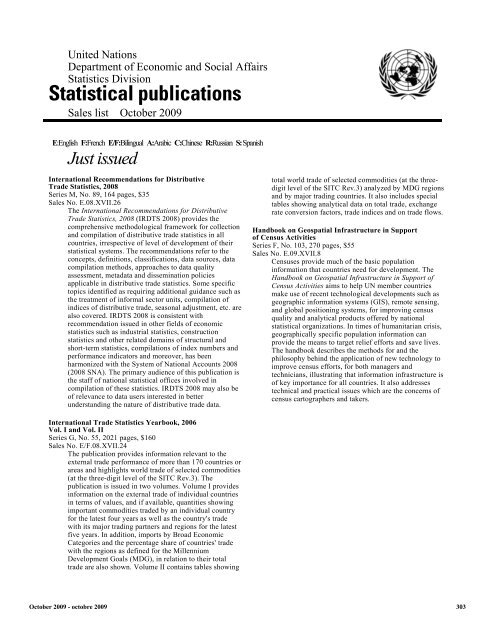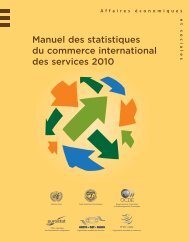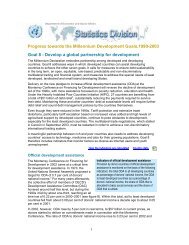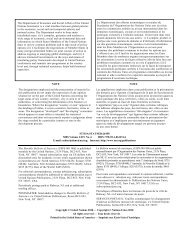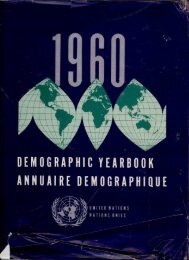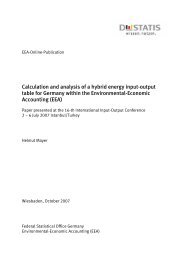dime NOTE The designations employed and the presentation of ...
dime NOTE The designations employed and the presentation of ...
dime NOTE The designations employed and the presentation of ...
You also want an ePaper? Increase the reach of your titles
YUMPU automatically turns print PDFs into web optimized ePapers that Google loves.
United Nations<br />
Department <strong>of</strong> Economic <strong>and</strong> Social Affairs<br />
Statistics Division<br />
Statistical publications<br />
Sales list October 2009<br />
E:English F:French E/F:Bilingual A:Arabic C:Chinese R:Russian S: Spanish<br />
Just issued<br />
International Recommendations for Distributive<br />
Trade Statistics, 2008<br />
Series M, No. 89, 164 pages, $35<br />
Sales No. E.08.XVII.26<br />
<strong>The</strong> International Recommendations for Distributive<br />
Trade Statistics, 2008 (IRDTS 2008) provides <strong>the</strong><br />
comprehensive methodological framework for collection<br />
<strong>and</strong> compilation <strong>of</strong> distributive trade statistics in all<br />
countries, irrespective <strong>of</strong> level <strong>of</strong> development <strong>of</strong> <strong>the</strong>ir<br />
statistical systems. <strong>The</strong> recommendations refer to <strong>the</strong><br />
concepts, definitions, classifications, data sources, data<br />
compilation methods, approaches to data quality<br />
assessment, metadata <strong>and</strong> dissemination policies<br />
applicable in distributive trade statistics. Some specific<br />
topics identified as requiring additional guidance such as<br />
<strong>the</strong> treatment <strong>of</strong> informal sector units, compilation <strong>of</strong><br />
indices <strong>of</strong> distributive trade, seasonal adjustment, etc. are<br />
also covered. IRDTS 2008 is consistent with<br />
recommendation issued in o<strong>the</strong>r fields <strong>of</strong> economic<br />
statistics such as industrial statistics, construction<br />
statistics <strong>and</strong> o<strong>the</strong>r related domains <strong>of</strong> structural <strong>and</strong><br />
short-term statistics, compilations <strong>of</strong> index numbers <strong>and</strong><br />
performance indicators <strong>and</strong> moreover, has been<br />
harmonized with <strong>the</strong> System <strong>of</strong> National Accounts 2008<br />
(2008 SNA). <strong>The</strong> primary audience <strong>of</strong> this publication is<br />
<strong>the</strong> staff <strong>of</strong> national statistical <strong>of</strong>fices involved in<br />
compilation <strong>of</strong> <strong>the</strong>se statistics. IRDTS 2008 may also be<br />
<strong>of</strong> relevance to data users interested in better<br />
underst<strong>and</strong>ing <strong>the</strong> nature <strong>of</strong> distributive trade data.<br />
total world trade <strong>of</strong> selected commodities (at <strong>the</strong> threedigit<br />
level <strong>of</strong> <strong>the</strong> SITC Rev.3) analyzed by MDG regions<br />
<strong>and</strong> by major trading countries. It also includes special<br />
tables showing analytical data on total trade, exchange<br />
rate conversion factors, trade indices <strong>and</strong> on trade flows.<br />
H<strong>and</strong>book on Geospatial Infrastructure in Support<br />
<strong>of</strong> Census Activities<br />
Series F, No. 103, 270 pages, $55<br />
Sales No. E.09.XVII.8<br />
Censuses provide much <strong>of</strong> <strong>the</strong> basic population<br />
information that countries need for development. <strong>The</strong><br />
H<strong>and</strong>book on Geospatial Infrastructure in Support <strong>of</strong><br />
Census Activities aims to help UN member countries<br />
make use <strong>of</strong> recent technological developments such as<br />
geographic information systems (GIS), remote sensing,<br />
<strong>and</strong> global positioning systems, for improving census<br />
quality <strong>and</strong> analytical products <strong>of</strong>fered by national<br />
statistical organizations. In times <strong>of</strong> humanitarian crisis,<br />
geographically specific population information can<br />
provide <strong>the</strong> means to target relief efforts <strong>and</strong> save lives.<br />
<strong>The</strong> h<strong>and</strong>book describes <strong>the</strong> methods for <strong>and</strong> <strong>the</strong><br />
philosophy behind <strong>the</strong> application <strong>of</strong> new technology to<br />
improve census efforts, for both managers <strong>and</strong><br />
technicians, illustrating that information infrastructure is<br />
<strong>of</strong> key importance for all countries. It also addresses<br />
technical <strong>and</strong> practical issues which are <strong>the</strong> concerns <strong>of</strong><br />
census cartographers <strong>and</strong> takers.<br />
International Trade Statistics Yearbook, 2006<br />
Vol. I <strong>and</strong> Vol. II<br />
Series G, No. 55, 2021 pages, $160<br />
Sales No. E/F.08.XVII.24<br />
<strong>The</strong> publication provides information relevant to <strong>the</strong><br />
external trade performance <strong>of</strong> more than 170 countries or<br />
areas <strong>and</strong> highlights world trade <strong>of</strong> selected commodities<br />
(at <strong>the</strong> three-digit level <strong>of</strong> <strong>the</strong> SITC Rev.3). <strong>The</strong><br />
publication is issued in two volumes. Volume I provides<br />
information on <strong>the</strong> external trade <strong>of</strong> individual countries<br />
in terms <strong>of</strong> values, <strong>and</strong> if available, quantities showing<br />
important commodities traded by an individual country<br />
for <strong>the</strong> latest four years as well as <strong>the</strong> country's trade<br />
with its major trading partners <strong>and</strong> regions for <strong>the</strong> latest<br />
five years. In addition, imports by Broad Economic<br />
Categories <strong>and</strong> <strong>the</strong> percentage share <strong>of</strong> countries' trade<br />
with <strong>the</strong> regions as defined for <strong>the</strong> Millennium<br />
Development Goals (MDG), in relation to <strong>the</strong>ir total<br />
trade are also shown. Volume II contains tables showing<br />
October 2009 - octobre 2009 303


